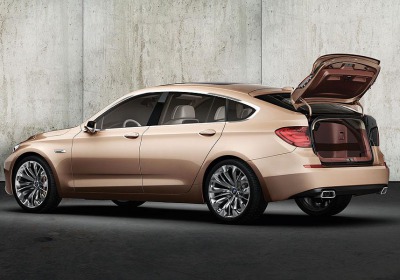BMW 5-series GT: Don't call this concept an MPV
Fri, 13 Feb 2009
BMW's desire to compete in every conceivable luxury-market niche has moved up a gear with the unveiling of the 5-series GT, a car known until now by its working title, the Progressive Activity Sedan (PAS).
Although BMW will be billing the five-door liftback as a concept at its public showing at the Geneva motor show in early March, little about its bold design is expected to change before it reaches showrooms.
In fact, the official photographs reveal the new car in its production-based glory. Only the trim will be altered before it sees the showroom, BMW says.
By insisting that it is called a GT, for Grand Turismo, BMW is attempting to avoid its latest model being described as an MPV. In reality, it is a combination of both, with a dash of sport-utility vehicle thrown in for good measure.
One of the primary reasons for the existence of the 5-series GT, according to BMW's outgoing design boss Chris Bangle, is an internal study that reveals an aging customer base that finds the traditional seating position of the 5-series sedan too sporting but at the same time considers the elevated seating in the X6 too imposing.
"This is the most customer-centered car we've ever done," Bangle said. "We discovered a group of BMW buyers we were failing to reach out to at a sales level. We wanted to build a car to suit their everyday needs. There were no preconceived ideas. Everything you see is customer driven."
The 5-series GT, which will be shown in production trim at the Frankfurt motor show in September (North American sales begin in 2010), is based on BMW's new large-car platform, first used by the redesigned 7-series. It rides on a unique 120.9-inch wheelbase that is expected to be shared with a long-wheelbase version of the next 5-series to be sold in the Chinese market.
At launch, the 5-series GT will be offered only with rear-wheel drive, although the xDrive four-wheel-drive system is planned to be offered as an option in the future.
The exterior styling is credited to young BMW designer Christopher Weil.
Below the 5-series GT's waistline, the appearance and body surfacing resembles that of the next-generation 5-series sedan due out next year. Above it, the roofline and corresponding window graphic mimics the X6. Weil also integrated elements of BMW's CS concept into the design, as seen by the shape of the headlamps.
The biggest exterior innovation is the 5-series GT's two-mode hatch opening mechanism. In the first mode, the vertical tailgate hinges upward, porthole style, to create a rectangular-shaped opening. In the second mode, the entire rear window and tailgate lift together to provide a large opening that is further aided by a parcel shelf that automatically folds away to provide unimpeded loading.
BMW dealerships will have to find precious real estate to accommodate the new car when it arrives in North American showrooms early next year. At 196.8 inches long and 61.2 inches tall, the 5-series GT is about six inches longer and 3.7 inches taller than today's 5-series sedan, which will be replaced by an all-new within the next year.
It is inside the car where BMW has directed much of its attention.
"We spent a long time developing the interior, with particular attention given to everyday use," says Oliver Heilner, who is credited with the cabin layout. "We wanted a car you could enter without difficulty and feel comfortable in over long journeys."
Among the steps to ensure a large door opening is the adoption of frameless doors.
"There was a compromise with conventional doors because the frame robbed valuable space along the top edge," Heilner said.
Inside, there's a luxuriously trimmed interior that draws heavily on the architectural look established on the new 7-series. The tall, 10-window greenhouse provides ample headroom, even in back where the roofline plunges dramatically. There's sufficient legroom in back to allow the 5-series GT to be used as a chauffeur-driven limousine.
The front seats have been elevated by 2.4 inches over those in the 5-sereis sedan, with the crucial H-point (the height of the hip above the ground) put at 22.6 inches. Still, it's a good 6.2 inches lower than the X6.
The concept bound for Geneva boasts a businesslike interior with four seats. However, production versions of the new BMW will get a bench rear seat to hold three people.
To help improve cabin refinement, BMW has provided the 5-series GT with a partition between the rear seat and the trunk.
"This helps isolate any noise emanating from the rear," says Heilner.
The rear seats fold flat to increase cargo space.
Early 5-series GT models are likely to offer a choice between the 272-hp naturally aspirated and an updated 326-hp twin-turbo version of BMW's 3.0-liter inline six-cylinder engine, along with a 407-hp turbocharged 4.4-liter V8. Also planned are 245-hp single turbo and 286-hp twin-turbo versions of its 3.0-liter inline six-cylinder common-rail diesel. Gearbox choices will include a standard six-speed manual on the base gasoline and diesel engines, with a newly developed eight-speed automatic on the others. Other engines will follow. Just don't expect a 507-hp 5.0-liter V10 GT-M5 version anytime soon.
As part of BMW's EfficientDynamics program, features such as start/stop and regenerative braking will come standard. Also being readied for the 5-series GT is the first stage in BMW's new thermal-electric generator technology.
Expect a standard steel spring setup on lower-end models, with an air suspension on high-end models. Active damping control will be standard.
Both active front steering and BMW's new active rear steering--introduced on the 7-series--will be available.
By Greg Kable

